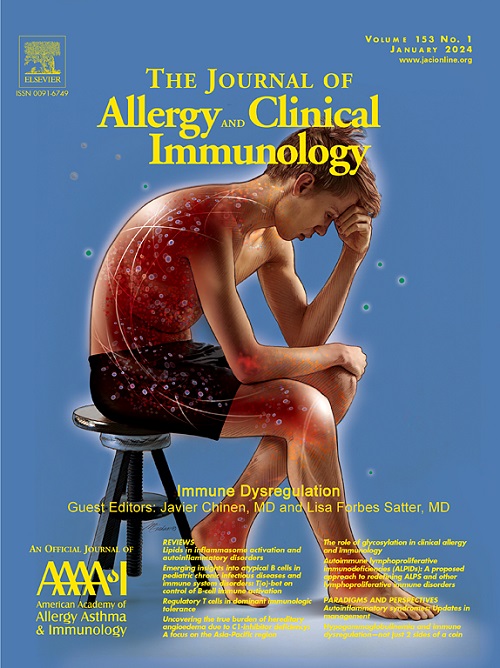共济失调性特发性远动病患者癌症和治疗相关毒性反应的发生率和结果。
IF 11.4
1区 医学
Q1 ALLERGY
引用次数: 0
摘要
背景:共济失调性远端连枷症(A-T)是一种具有癌症易感性的DNA修复障碍:目的:描述共济失调性远端连枷症患者中血液系统和实体瘤的发病率和结果以及治疗相关毒性:方法:对约翰霍普金斯大学共济失调性远端连枷症临床中心队列中的数据进行回顾性分析。计算了癌症的累积发病率和标准化发病率比、癌症确诊后的生存概率以及标准化死亡率比。Cox回归根据化疗(标准剂量与减量剂量)估算死亡风险,多变量Logistic回归评估癌症风险与ATM外显子和变异的关联:508人中有84人(16.5%)被诊断为原发性癌症,其中62人(74%)为血液系统癌症,22人(26%)为实体器官癌症。到 35 岁时,癌症的累积发病率为 29%。非霍奇金淋巴瘤的发病率最高(39 人),而实体瘤对年龄≥18 岁者的影响更大(22 人)。总体标准化死亡率为24.6(95% CI:21.1-28.4),癌症患者的标准化死亡率为232.9(95% CI:178.1-299.2)。与改良化疗相比,标准/未知化疗的死亡风险更高(HR 2.2,95% CI:1.1-4.4,P=0.024)。58%的患者出现化疗相关毒性,主要是神经系统(14人)和胃肠道系统(10人)。三个外显子富含癌症相关变异:结论:A-T 患者会罹患多种血液和实体器官恶性肿瘤,死亡率高,并伴有治疗相关毒性,因此需要靶向疗法来减轻毒性和优化生存:临床意义:A-T 癌症患者的死亡率很高,这说明迫切需要量身定制的疗法来减少毒性并改善生存结果。本文章由计算机程序翻译,如有差异,请以英文原文为准。

Prevalence and outcomes of cancer and treatment-associated toxicities for patients with ataxia telangiectasia
Background
Ataxia telangiectasia (A-T) is a DNA repair disorder with cancer predisposition.
Objective
We sought to characterize the prevalence and outcomes of hematologic and solid cancers and treatment-associated toxicities in individuals with A-T.
Methods
Data were retrospectively analyzed from the Johns Hopkins Ataxia Telangiectasia Clinical Center cohort. Cumulative incidence and standardized incidence ratios of cancer, survival probability after cancer diagnosis, and standardized mortality ratios were calculated. Cox regression estimated risk of death on the basis of chemotherapy (standard vs reduced) dosing, and multivariable logistic regression evaluated cancer risk associations with ataxia telangiectasia mutated (ATM) exons and variants.
Results
Eighty-four (16.5%) of 508 individuals were diagnosed with a primary cancer, of whom 62 (74%) were hematologic in origin and 22 (26%) were solid-organ cancers. The cumulative incidence of cancer was 29% by age 35 years. Non–Hodgkin lymphoma occurred most frequently (n = 39), whereas solid cancers disproportionately affected those 18 years and older (n = 22). The standardized mortality ratio was 24.6 (95% CI, 21.1-28.4) overall and 232.9 (95% CI,178.1-299.2) among individuals with cancer. Risk of death was higher when treated with standard/unknown versus modified chemotherapy (hazard ratio, 2.2; 95% CI, 1.1-4.4; P = .024). Chemotherapy-associated toxicities developed in 58% of individuals, predominantly neurologic (n = 14) and gastrointestinal (n = 10) systems. Three exons were enriched for cancer-associated variants.
Conclusions
Individuals with A-T experience a wide array of blood and solid-organ malignancies, high mortality rates, and treatment-related toxicities, highlighting need for targeted therapies to mitigate toxicity and optimize survival.
求助全文
通过发布文献求助,成功后即可免费获取论文全文。
去求助
来源期刊
CiteScore
25.90
自引率
7.70%
发文量
1302
审稿时长
38 days
期刊介绍:
The Journal of Allergy and Clinical Immunology is a prestigious publication that features groundbreaking research in the fields of Allergy, Asthma, and Immunology. This influential journal publishes high-impact research papers that explore various topics, including asthma, food allergy, allergic rhinitis, atopic dermatitis, primary immune deficiencies, occupational and environmental allergy, and other allergic and immunologic diseases. The articles not only report on clinical trials and mechanistic studies but also provide insights into novel therapies, underlying mechanisms, and important discoveries that contribute to our understanding of these diseases. By sharing this valuable information, the journal aims to enhance the diagnosis and management of patients in the future.

 求助内容:
求助内容: 应助结果提醒方式:
应助结果提醒方式:


